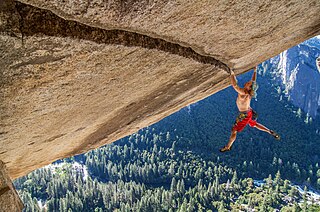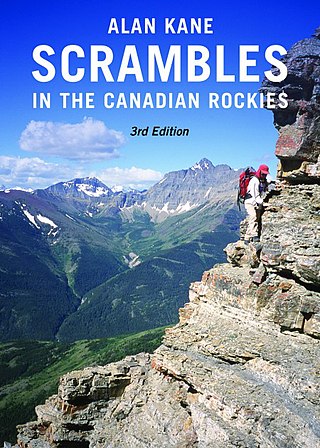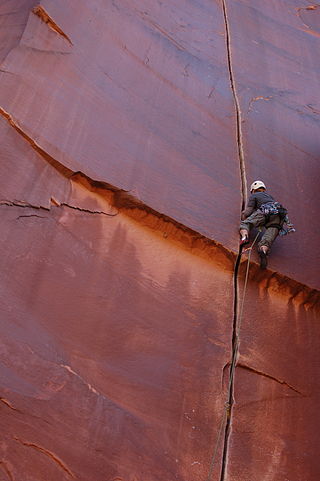Related Research Articles

Bouldering is a form of free climbing that is performed on small rock formations or artificial rock walls without the use of ropes or harnesses. While bouldering can be done without any equipment, most climbers use climbing shoes to help secure footholds, chalk to keep their hands dry and to provide a firmer grip, and bouldering mats to prevent injuries from falls. Unlike free solo climbing, which is also performed without ropes, bouldering problems are usually less than six metres (20 ft) tall. Traverses, which are a form of boulder problem, require the climber to climb horizontally from one end to another. Artificial climbing walls allow boulderers to climb indoors in areas without natural boulders. In addition, bouldering competitions take place in both indoor and outdoor settings.

Climbing is the activity of using one's hands, feet, or other parts of the body to ascend a steep topographical object that can range from the world's tallest mountains to small boulders. Climbing is done for locomotion, sporting recreation, for competition, and is also done in trades that rely on ascension, such as rescue and military operations. Climbing is done indoors and outdoors, on natural surfaces, and on artificial surfaces

A climbing route is a path by which a climber reaches the top of a mountain, or rock/ice-covered obstacle. The details of a climbing route are recorded in a climbing guidebook and/or in an online climbing route database, and will include elements such as the type of climbing route, the difficulty grade of the route–and beta on its crux(es)–and any risk or commitment grade, the length and number of pitches of the route, and the climbing equipment needed to complete the route.

Glossary of climbing terms relates to rock climbing, mountaineering, and to ice climbing.

Climbing guidebooks are used by mountaineers, alpinists, ice climbers, and rock climbers to locate, grade, and navigate climbing routes on mountains, climbing crags, or bouldering areas. Modern route guidebooks include detailed information on each climbing route, including topo diagrams, route beta, protection requirements, and the ethics and style that are in place for a given climbing area.

Chris Omprakash Sharma is an American rock climber who is considered one of the greatest and most influential climbers in the history of the sport. He dominated sport climbing for the decade after his 2001 ascent of Realization/Biographie, the world's first-ever redpoint of a consensus 9a+ (5.15a) graded route, and ushered in what was called a "technical evolution" in the sport. Sharma carried the mantle of "world's strongest sport climber" from Wolfgang Güllich, and passed it to Adam Ondra.

Rock climbing is a sport in which participants climb up, across, or down natural rock formations or indoor climbing walls. The goal is to reach the summit of a formation or the endpoint of a usually pre-defined route without falling. Rock climbing is a physically and mentally demanding sport, one that often tests a climber's strength, endurance, agility and balance along with mental control. Knowledge of proper climbing techniques and the use of specialized climbing equipment is crucial for the safe completion of routes.

Fair Head or Benmore is a 5-kilometre (3.1 mi) long, 200-metre (660 ft) high, mountain cliff, close to the sea, at the north-eastern corner of County Antrim, Northern Ireland. The cliff's sheer and vertical 100-metre (330 ft) high dolerite rock face is shaped into distinctive vertical columns like organ pipes, which formed 60 million years ago when a sill of igneous rock was injected between horizontal Carboniferous sediments.
The Mount Nemo Conservation Area in Burlington, Ontario is a conservation area owned and operated by Conservation Halton. It is popular with rock climbers in the Greater Toronto Area and the Golden Horseshoe, along with nearby Rattlesnake Point Conservation Area. Its five kilometers of hiking trails connect with the Bruce Trail.

Ron Kauk is an American rock climber. Kauk is associated with Camp 4 in Yosemite Valley, where he lived for decades, now a resident of El Portal, California.

Rattlesnake Point is an eco-tourism area located in Milton, Ontario, Canada and is owned and operated by Conservation Halton. Spanning roughly one hundred square kilometres across and near the Niagara Escarpment in Halton Region, the Rattlesnake Point area is home to many golf courses, country markets and equestrian training and boarding facilities. It is a popular scouting area.
Quartz Mountain is located in Greer County in southwest Oklahoma. It is the namesake of Quartz Mountain Nature Park and the park boundaries enclose its eastern flank. It is near the cities of Mangum, Oklahoma and Altus, Oklahoma. The park is open to the public year-round for rock climbing, hiking, boating, camping, nature observation and photography, and environmental education and interpretation. The mountain overlooks scenic Lake Altus-Lugert.

Eldorado Canyon State Park is part of the Colorado State Park system. It was established in 1978 and is located in Boulder County near the city of Boulder. The park consists of two areas, the Inner Canyon and Crescent Meadows. The park encompasses 885 acres (3.6 km2) with a variety of recreation opportunities available. Eldorado Canyon is home to one of the world's most accessible and comprehensive rock climbing areas. This state park is open during daylight hours only, visitors are expected to leave before dusk.

Eldorado Mountain is a mountain summit on the eastern flank of the Front Range of the Rocky Mountains of North America. The 8,344-foot (2,543 m) peak is located 8.1 miles (13.1 km) south by west of downtown Boulder, Colorado, United States. The mountain is largely in Boulder County but it straddles the border and its southern flanks are located in Jefferson County. Its name was probably borrowed from the nearby community of Eldorado Springs.

Farley Ledges, 1,067 feet (325 m) is a bluff knob located on the southeast side of Northfield Mountain in eastern Franklin County, Massachusetts. The ledge is notable for its extensive rock climbing ascents; it rises 700 feet (210 m) above the small village of Farley and has been used by rock climbers since the 1930s. The Western Massachusetts Climbers Coalition has been active in purchasing land to preserve access to the mountain; 2007 purchases included a parcel along Route 2 developed into a trailhead with a parking lot and access corridor to the ledges. The 110-mile (180 km) Metacomet-Monadnock Trail ascends the wooded north side of the ledges where Briggs Brook Falls tumbles from the ridgecrest; a marked rock climbing access loop trail departs from the Metacomet-Monadnock Trail to traverse both the summit of the ledges and the extensive boulder field beneath.

In climbing and mountaineering, a traverse is a section of a climbing route where the climber moves laterally, as opposed to in an upward direction. The term has broad application, and its use can range from describing a brief section of lateral movement on a pitch of a climbing route, to large multi-pitch climbing routes that almost entirely consist of lateral movement such as girdle traverses that span the entire rock face of a crag, to mountain traverses that span entire ridges connecting chains of mountain peaks.

Niagara Glen is a nature reserve located near the Niagara Whirlpool along the Canadian side of the Niagara Gorge. It is one of the best preserved remaining examples of Southern Ontario's original Carolinian forest. The park is operated by the Niagara Parks Commission, an agency of the Ontario government. The park features overlooks of the whirlpool and gorge as well as several hiking trails through the Carolinian forest. The nature reserve also protects a pristine area of the Niagara Escarpment.

Sasha DiGiulian is a professional rock climber who specializes in competition climbing, sport climbing and bouldering. She won the gold medal at the 2011 International Federation of Sport Climbing World Championships in Arco, Italy, for Female Overall, placed Silver in Bouldering and Bronze in Duel. Sasha won multi-year PanAmerican championships and is a three-time US National Champion.
Steve Bechtel is a rock climber, coach, and author based in Lander, Wyoming. He has been important in developing climbing around the region since the 1990s. Bechtel is considered a prime suspect in the unsolved disappearance of his first wife, Amy Wroe Bechtel.

Sean Bailey is an American professional rock climber, who specializes in competition climbing, sport climbing, and bouldering. He has represented the United States in the IFSC Climbing World Cup in lead climbing, and has two podium finishes in bouldering at individual legs of the World Cup, including a win at the Salt Lake City leg of the 2021 World Cup.1 and three in lead climbing, including two gold medals, at the Villars leg, and Chamonix leg, in July 2021.
References
- ↑ "OAC Home". Ontario Alliance of Climbers.
- ↑ "OAC 2020 AGM Recap". August 26, 2020.
- ↑ "Near Niagara Falls, a 'secret' bouldering spot grows in popularity". The Globe and Mail. November 9, 2017.
- ↑ Mills, Chris (February 27, 2015). "Bouldering Totally Rocks". Niagara Escarpment Views. Niagara, Ontario: Niagara Escarpment Views. pp. 28–31, 42–44.
- ↑ "Climbers & Conservationists Unite!". www.mountainlifemedia.ca. May 4, 2015.
- ↑ "CA purchases land near Old Baldy in Grey Highlands". Toronto.com. October 9, 2014.
- ↑ "Old Baldy Access Victory". www.ontarioclimbing.ca.
- ↑ Hildebrandt, Gloria (May 28, 2018). "The Changing Cliff Face of Climbing" (PDF). Niagara Escarpment Views. Niagara, Ontario: Niagara Escarpment Views. pp. 42–49.
- ↑ "Major Access Victory in Ontario". www.gripped.com. May 19, 2010.
- ↑ "Ontario Access to Remain Open to Niagara Escarpment Crags". www.gripped.com. February 10, 2017.
- ↑ "Lions Head's Latvian Ledge Remains "Closed" : OAC Statement". Gripped.com. July 24, 2020.
- ↑ "The perils of taking indoor rock climbing outside". thestar.com. November 24, 2017.
- ↑ Melnick, Zach (director) (December 31, 2020). Striking Balance - Niagara Escarpment (Television production). Niagara Escarpment: TVO.
- ↑ "Thanks to Ontario Alliance of Climbers for Rattlesnake Updates". gripped.com. May 17, 2019.
- ↑ "Festival will bring hundreds of ice climbers to Maynooth in February". kawarthanow.com. December 9, 2018.